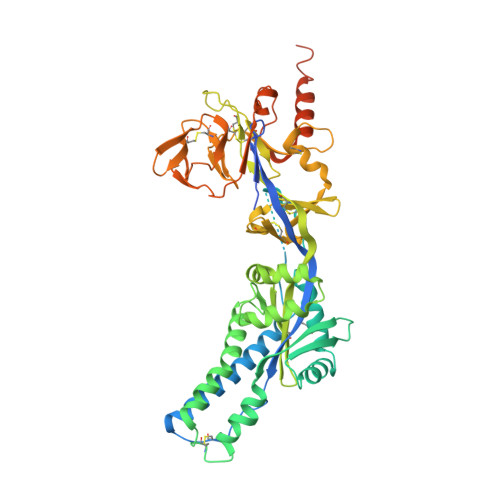Crystal Structure and Immunogenicity of the DS-Cav1-Stabilized Fusion Glycoprotein From Respiratory Syncytial Virus Subtype B.
Joyce, M.G., Bao, A., Chen, M., Georgiev, I.S., Ou, L., Bylund, T., Druz, A., Kong, W.P., Peng, D., Rundlet, E.J., Van Galen, J.G., Wang, S., Yang, Y., Zhang, B., Chuang, G.Y., McLellan, J.S., Graham, B.S., Mascola, J.R., Kwong, P.D.(2019) Pathog Immun 4: 294-323
- PubMed: 31893251
- DOI: https://doi.org/10.20411/pai.v4i2.338
- Primary Citation of Related Structures:
6Q0S - PubMed Abstract:
Respiratory syncytial virus (RSV) subtypes, A and B, co-circulate in annual epidemics and alternate in dominance. We have shown that a subtype A RSV fusion (F) glycoprotein, stabilized in its prefusion conformation by DS-Cav1 mutations, is a promising RSV-vaccine immunogen, capable of boosting RSV-neutralizing titers in healthy adults. In both humans and vaccine-tested animals, neutralizing titers elicited by this subtype A DS-Cav1 immunogen were ~ 2- to 3-fold higher against the homologous subtype A virus than against the heterologous subtype B virus. To understand the molecular basis for this subtype difference, we introduced DS-Cav1 mutations into RSV strain B18537 F, determined the trimeric crystal structure, and carried out immunogenicity studies. The B18537 DS-Cav1 F structure at 2-Å resolution afforded a precise delineation of prefusion F characteristics, including those of antigenic site Ø, a key trimer-apex site. Structural comparison with the subtype A prefusion F indicated 11% of surface residues to be different, with an alpha-carbon root-mean-square deviation (RMSD) of 1.2 Å; antigenic site Ø, however, differed in 23% of its surface residues and had an alpha-carbon RMSD of 2.2 Å. Immunization of vaccine-tested animals with DS-Cav1-stabilized B18537 F induced neutralizing responses ~100-fold higher than with postfusion B18537 F. Notably, elicited responses neutralized RSV subtypes A and B at similar levels and were directed towards both conserved equatorial and diverse apical regions. We propose that structural differences in apical and equatorial sites-coupled to differently focused immune responses-provide a molecular explanation for observed differences in elicited subtype A and B neutralizing responses.
- Vaccine Research Center, National Institute of Allergy and Infectious Diseases, National Institutes of Health, Bethesda, Maryland.
Organizational Affiliation:

















